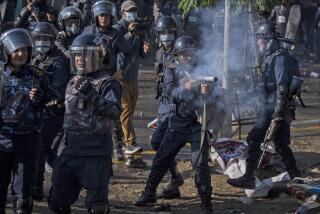Large protests by Tibetans in western China
- Share via
BEIJING — Hundreds of Tibetans surrounded a police station and government offices in a remote enclave of western China after the apparent suicide of a monk who had been taken into police custody.
The protests near the Rabgya Monastery were the largest this year and show how volatile the situation remains despite the deployment of tens of thousands of paramilitary troops.
Official Chinese media reported that six people were arrested and that 89 “surrendered to police” after hundreds “attacked the police station . . . assaulted policemen and government staff,” leaving several slightly injured.
“The social order of the Rabgya area has been restored,” an official was quoted as telling the New China News Agency in a report published Sunday.
A Tibetan exile news service said the protests were triggered by the suicide of a 28-year-old monk whom they identified as Tashi Sangpo. Sangpo had been arrested several days earlier at the monastery for keeping a banned Tibetan flag and political leaflets in his room, it said. On Saturday, he escaped from the police station and killed himself by jumping into a river, according to the Phayul.com news service.
“Angry protesters managed to snatch from police the Tibetan national flag that was earlier confiscated by the Chinese officials,” said the Phayul report, which also said that thousands were involved in the protest. A short video taken from a cellphone and posted on the group’s website showed a large crowd of crimson-robed monks and civilians.
Chinese authorities closed roads and cut off telephone lines, text messages and Internet service to the isolated Tibetan enclave in Qinghai province, making it impossible to independently verify what happened. The only reports in the Chinese media were carried by the official news agency.
This month marks the 50th anniversary of the exile of the Dalai Lama, Tibet’s spiritual leader, a traditional season of protest for Tibetans. Last year at this time, the largest protests in decades spread from the Tibetan capital of Lhasa into Tibetan enclaves throughout western China.
--
More to Read
Sign up for Essential California
The most important California stories and recommendations in your inbox every morning.
You may occasionally receive promotional content from the Los Angeles Times.










